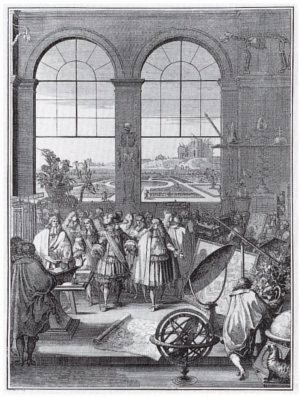
There were interesting differences between the Academies of Science in England, France and Prussia. Members of the Academies in Paris and Berlin were appointed by the king, received a salary and were effectively servants of the state.
In contrast, the British bourgeoisie was frugal with expenses on science; London was the only capital city without a university, and the Royal Society did not offer its members any remuneration. King Charles II was its patron but did not spend a cent on it and spoke quite disparagingly of its members - the Italian Lorenzo Magalotti reported about his visit to London in 1667:
Many members of Academies were political appointments and not necessarily scientists. The French Academy had to introduce the category of "supernumerary member" to allow the appointment of outstanding scientists through the Academy itself. The Royal Society did appoint its members itself; yet over 40% of its members were of the nobility and rarely cared to pay the regular subscription.
Differences could also be observed in the meeting style. Meetings of the Royal Society were usually free discussions of matters of general interest that came to hand, such as reports on experiments members had performed. The Academy in Paris, on the other hand, was structured into six classes - geometry, astronomy, mechanics, anatomy, chemistry and botany, with the addition of general physics and mineralogy after 1785 - of eight members in each class (in 1785 reduced to six). It created the first weekly scientific publication, the Journal des Savans, and acted as a kind of Patent Office by issuing the "royal privilege for machines." From 1720 it organized regular competitions and generally aimed at directing the progress of scientific understanding. (Bensaude-Vincent, 1995)

King Louis XIV visits the Académie des Sciences in 1671.
Engraving by Sebastien Le Clerc published in the Mémoires pour servir a l'Histoire Naturelle des Animause, Paris, 1671.
The scene depicts a visit of the king to the Academy, a room attached to the King's Library in the Rue Vivienne in Paris (not far from today's Bibliotheque Nationale). Members of the royal court are shown in the foreground, the academicians behind them. The room is filled with maps, instruments, skeletons and stuffed animals.
The new observatory under construction in 1671 can be seen through the window. In reality it was more than 3 km away; the artist positioned it closer to allow its inclusion in the scene.
Bensaude-Vincent, B. (1995) Lavoisier: a Scientific Revolution. In: M. Serres (editor): A History of Scientific Thought, Elements of a History of Science. Blackwell, Oxford, 455 - 482. (Translation of Éléments d'Histoire des Sciences, Bordas, Paris, 1989)
Hall, A. R. (1983) The Revolution in Science 1500 - 1750. Longman, London.